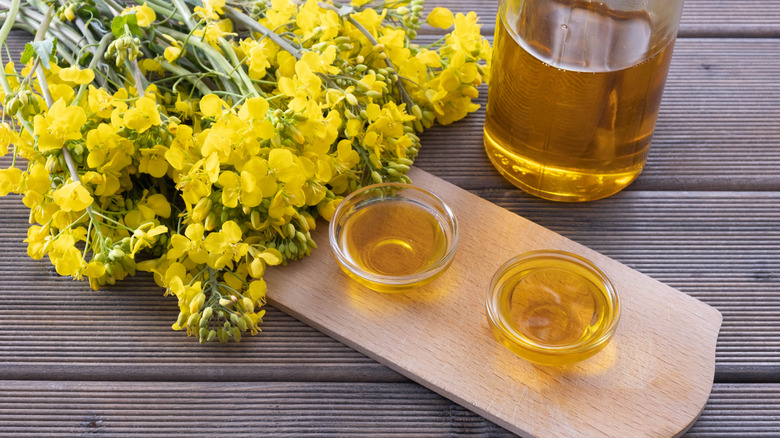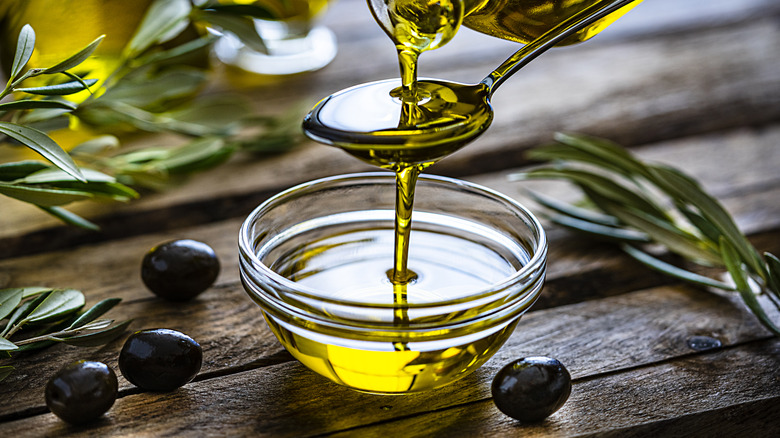Why Bobby Flay Chooses Canola Over Olive Oil
Bobby Flay is more than just an Iron Chef, though he is an Iron Chef. He is more than a cookbook author, though he is a cookbook author. He is more than a restauranteur, although he does boast more than one eatery under his belt. Yes, Bobby Flay wears many hats. The Food Network mainstay has been guiding home cooks and pushing the boundaries of the culinary world for decades. He knows the perfect and somewhat unconventional topping for your cookout burger (pimento cheese), and he has some pretty solid cooking opinions, including his choice of cooking oil.
It seems that, regarding his choice of cooking oil, Flay likes to keep things simple, choosing to use canola oil, a pantry mainstay, in much o his cooking. In an interview with Bon Appétit, Flay revealed his oil preference. "98% of the time," Flay said, "I cook with canola oil." And what is Flay's reasoning for using canola oil so liberally in cooking? For one, canola oil has a high smoke point, higher than olive oil, which makes it ideal for cooking methods such as pan frying. Additionally, Flay notes that " ... because it's so neutral, it's not going to change the flavor of what I'm making." So you won't have to worry about burning your oil or infusing your food with too strong of a flavor, and that's good news for many recipes.
Give canola oil a chance
So what exactly is canola oil? Essentially, canola oil is a type of oil that is derived from rapeseed. Before it was used as an ingredient in foods, rapeseed oil was used to lubricate pieces of machinery, as the oil wasn't considered safe for human consumption. This is because the oil contained erucic acid, considered a toxic substance. So why do we use rapeseed (canola) oil now? Well, in 1973 a group of scientists were able to produce a rapeseed that was safe for human consumption. The resulting oil was named canola oil.
Since its invention in the 1970s, it has become one of the most popular oils in the United States. And it's easy to see why. Canola oil is a neutral oil, so you don't have to contend with a strong flavor while cooking. Rather, your other ingredients will be able to shine through. For this reason, canola oil is fantastic for sauteing, making stews, or hearty beef chili – which features a spice-heavy flavor — and baking. In addition to its (lack of) flavor, canola oil has a smoke point of between 400 degrees and 450 degrees Fahrenheit, making it perfect for cooking at higher heat. The oil is also relatively low in saturated fat, making it a good oil for anyone keeping an eye on their saturated fat consumption.
When to reach for olive oil
Okay, canola oil is a great neutral oil that can stand up to the heat of cooking. But what if you miss that delicious, rich taste of olive oil? Well, Bobby Flay has got you covered there. Instead of cooking with it, Flay uses it almost as a garnish. He notes in his Bon Appétit interview, "I can always finish a dish with a drizzle of olive oil." But why drizzle your food with olive oil rather than cooking with it?
For one, cooking with olive oil isn't always a guarantee of flavor, as heat breaks down many of the compounds that make the oil so rich and tasty. So, rather than using olive oil as a cooking oil, you might consider using it as a topper, ensuring that your olive oil maintains its rich, delicious flavor. If you're skeptical of olive oil's capabilities as a topping, try a bowl of ice cream with a drizzle of olive oil.
Of course, if you really want to cook with olive oil, you should use it in dishes where its flavor will truly shine. Using olive oil as a base for a simple red sauce, for example, can make the most of the oil's taste and smooth texture, adding a bit more of a flavor punch than canola oil at the base. Even so, adding a drizzle of olive oil at the end of your sauce-making process can go a long way, and might just give you all of the olive oil flavor you want.


